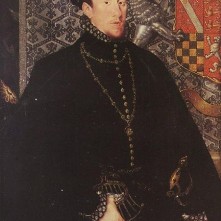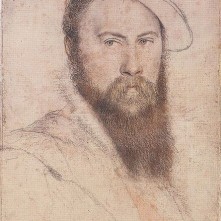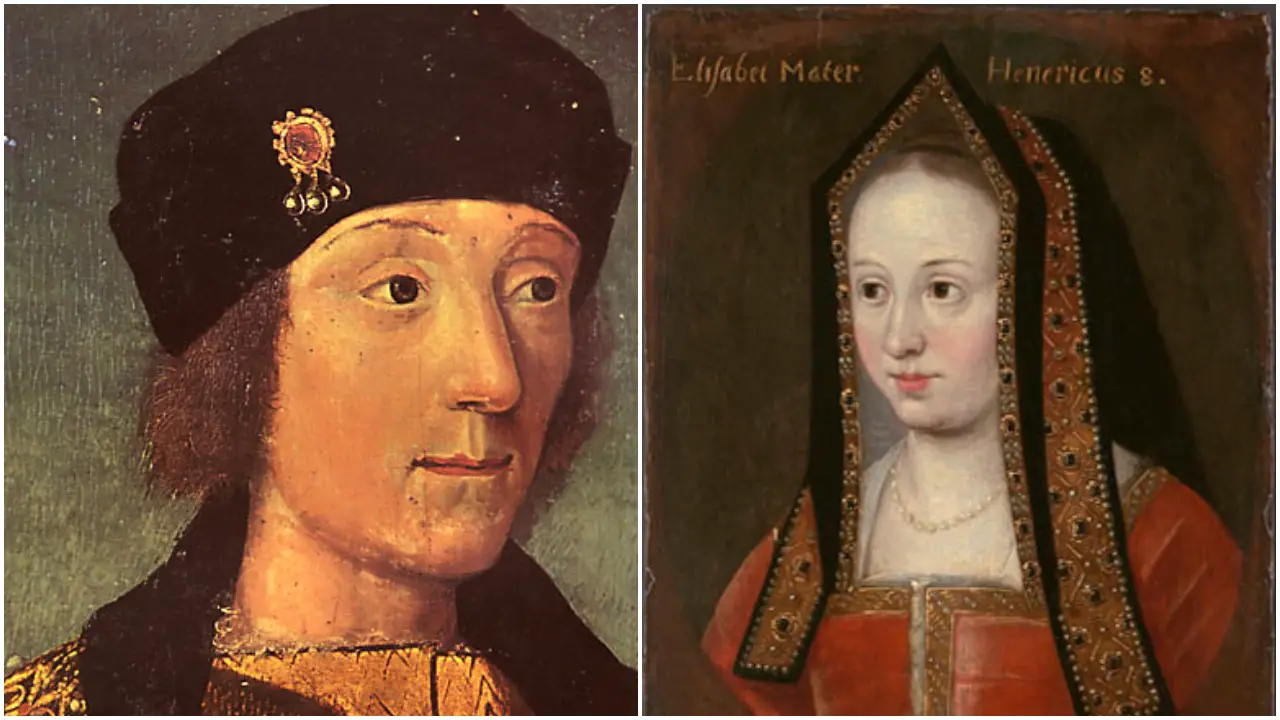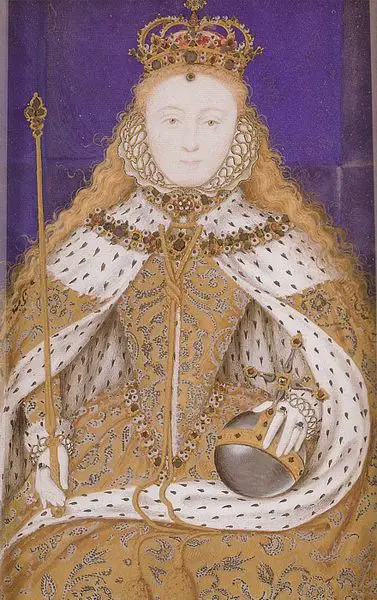16 January
1486 – The Bishop of Imola, the papal legate, authorised the marriage of Henry VII and Elizabeth of York, which was due to take place on 18th January.
1501 – Birth of Sir Anthony Denny, courtier and close friend of Henry VIII, at Cheshunt. He was the second son of Sir Edmund Denny and his wife, Mary.
1549 - Thomas Seymour was alleged to have broken into Edward VI's apartments at Hampton Court Palace to kidnap the young King. Click here to read more about this incident.
1558 – Death of Thomas Alsop, Chief Apothecary to Henry VIII and Serjeant of the Royal 'Confectionary' to Edward VI. He was buried in St Mary Woolchurch.
1572 – Thomas Howard, 4th Duke of Norfolk, was tried and found guilty of treason at Westminster Hall.
1585 – Death of Edward Fiennes Clinton, 1st Earl of Lincoln, military commander, in London. He was buried in St George's Chapel, Windsor Castle. Clinton served Elizabeth I as a privy councillor and Lord Admiral until his death.
1606 – Death of Matthew Hutton, Archbishop of York, at Bishopthorpe. He was buried at York Minster.
17 January
1504 – Birth of Pope Pius V, at Bosco in the Duchy of Milan, Italy. He was born Antonio Ghislieri.
1517 – Birth of Henry Grey, Duke of Suffolk and father of Lady Jane Grey, at Bradgate, Leicestershire. He was the son of Thomas Grey, 2nd Marquis of Dorset, and Margaret Wotton. Suffolk was executed at the Tower of London on 23rd February 1554 for his part in Wyatt's Rebellion.
1541 – Sir Thomas Wyatt the Elder, courtier, diplomat and poet, was arrested and sent to the Tower of London after being accused of corresponding with Cardinal Pole, and referring to the prospect of Henry VIII's death.
1562 – Edict of Saint-Germain, or Edict of January. This edict, issued by the regent of France, Catherine de' Medici, aimed at ending the persecution of the Huguenots by allowing them freedom of belief and private worship.
1569 - Agnes Bowker of Market Harborough, Leicestershire, allegedly gave birth to a cat. According to the midwife, Elizabeth Harrison, Agnes had told her of how “the likeness of a bear, sometimes like a dog, sometimes like a man” had carnal knowledge of her in its various guises.
1587 – Death of Bartholomew Newsam, famous clockmaker and sundial maker. He was buried in the church of St Mary-le-Strand. Examples of his work can still be seen in the British Museum.
18 January
1486 - The twenty-nine year-old Henry VII married the twenty year-old Elizabeth of York.
1510 - the King and twelve of his men disguised themselves as outlaws, or Robin Hood and his men, and surprised Queen Catherine and her ladies in the Queen’s chamber - click here to read more.
1543 – Baptism of Alfonso Ferrabosco, composer and court musician at the court of Elizabeth I, at the Cathedral of San Petronio, Bologna, Italy.
1616 – Burial of John Bettes the Younger, portrait painter, at St Gregory by St Paul's.
19 January
1547 - The poet, courtier and soldier Henry Howard, Earl of Surrey and son of Thomas Howard, 3rd Duke of Norfolk, was executed by beheading on Tower Hill. He was laid to rest at All Hallows-by-the-Tower (All Hallows Barking), but was moved in 1614 by his son Henry, Earl of Northampton, to a beautiful tomb in the family church, St Michael's at Framlingham.
1561 – Death of Sir Edward Carne, administrator and diplomat, in Rome. Carne carried out diplomatic missions for Henry VIII, was a Royal Commissioner during the dissolution of the monasteries, negotiated the marriage of Henry VIII and Anne of Cleves, and was Mary I's English ambassador to Rome.
1601 – Death of Henry Herbert, 2nd Earl of Pembroke, at Wilton, near Salisbury. Herbert was the son of William Herbert, 1st Earl of Pembroke, and Anne Parr, sister of Queen Catherine Parr. He was a friend of Robert Dudley, Earl of Leicester, and patron of the theatre company, Pembroke's Men.
1636 – Death of Marcus Gheeraerts, painter, in London. He is known for his “Ditchley” portrait of Elizabeth I.
20 January
1525 – Death of Richard Bere, Abbot of Glastonbury. He was buried in the south aisle of the nave of the abbey church.
1557 - “The Queen's Grace's pensioners did muster in bright harness” before Mary I.
1558 – The state opening of the fifth Parliament of Mary I's reign. This is one of the only mentions of a public appearance by Mary after the second departure of her husband, Philip of Spain, in July 1557.
1569 - Bible translator and Bishop of Exeter, Miles Coverdale died. He was buried in the chancel of St Bartholomew by the Exchange, London, on 22nd January.
1607 – Death of Jacob Verzelini, glassmaker, in Crutched Friars, London. He was buried at Downe Chapel. His work, which includes a cylindrical crystal tankard with silver-gilt lid and base and goblets, can be found in the British Museum and in the Victoria and Albert Museum.
1618 – Death of Ferdinando Putlon, legal researcher and writer, at Bourton, near Buckingham. He was buried in the parish church at Desborough.
21 January
1510 – Henry VIII opened the first Parliament of his reign.
1542 – Bill of Attainder passed against Catherine Howard, Henry VIII's fifth wife.
1543 - There was trouble in London. A group of half a dozen young men, including ringleader Henry Howard, Earl of Surrey, went on a five hour rampage smashing windows, shooting prostitutes using stonebows and shouting obscenities
1556 – Death of Eustace Chapuys, Imperial Ambassador at the English court from 1529-1545, at Louvain. He was laid to rest in the Chapel of Louvain College, the college he had founded.
1571 – Death of Walter Haddon, civil lawyer, reformer, MP and college head, in London. He was buried at Christ Church Greyfriars. As well as his work in colleges, Haddon is known for his polemical exchange with Portuguese priest Jerome Osorio da Fonseca who, in 1563, published an epistle calling for Elizabeth I to return to Catholicism, and Haddon was ordered by the government to reply.
1608 – Death of Sir Richard Lowther, soldier and landowner, at Lowther Hall. He was buried at the church in Lowther. His offices included Sheriff of Cumberland and Lord Warden of the West March.
22 January
1528 – Henry VIII and Francis I declared war on Charles V, Holy Roman Emperor.
1552 - Former Lord Protector of England, Edward Seymour, Duke of Somerset, was executed by beheading on Tower Hill in London. He was laid to rest in the Chapel of St Peter ad Vincula at the Tower of London, and records show that he was buried next to Anne Boleyn in the chancel area. Click here to read more.
1554 - Thomas Wyatt the Younger met with fellow conspirators at his home of Allington Castle in Kent to make final plans for their uprising (Wyatt's Rebellion) against Mary I and her decision to marry Philip of Spain - click here to read more.
1561 - Birth of Francis Bacon, Viscount St Alban, the Elizabethan Lord Chancellor, politician, philosopher, author and scientist, at York House in the Strand, London. Bacon is known as "the Father of the Scientific method" and developed an investigative method, the Baconian method, which he put forward in his book Novum Organum in 1620. Some people (Baconians) believe that Francis Bacon was the true author of William Shakespeare's plays.
1575 – Death of James Hamilton, 2nd Earl of Arran and Duke of Châtelherault, at Kinneil. Arran was appointed Regent for the infant Mary, Queen of Scots after James V's death in 1542, but surrendered the regency to Mary's mother, Mary of Guise in 1554.
1613 – Death of Sir David Williams, Serjeant-at-Law in Elizabeth I's reign and Puisne Justice of the King's Bench in James I's reign, from a fever at Kingston House, Kingston Bagpuize, Berkshire. His body was buried at St John's Chapel, Brecon, and his entrails were buried at Kingston.









Leave a Reply